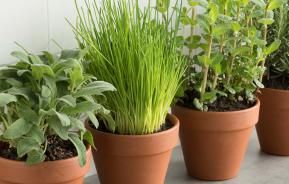Pots and planters come in all shapes and sizes. They may be:
- Purely functional
- Functional as well as decorative
- Plastic or similar man-made material
- Glazed or natural ceramic
- Plain terracotta / clay
- Brightly coloured
- Tall and slender
- Wide and squat
- With or without saucers
- With chains or hangers so they can be hung up
- Very large but lightweight for rooftop or balcony gardens
- So heavy that once they're in position they have to stay the
The range is enormous. There's always 'The One' that's perfect for the plant and position you have in mind - you just have to find it!
Get the proportions right
When looking for the right pot for a particular plant, take into consideration the proportions between plant and pot.
A small, squat plant in a tall narrow pot looks odd - as our image shows! Along the same lines, a very large shrub in a small pot will not only look just as silly but it may also be so top heavy that it will blow over in the gentlest of breezes.
Form and function are as important as one another. Choose a container of a suitable height that will also comfortably hold the plant you are potting up, with about 30mm clearance around the existing root ball.
Don't think that by choosing a pot several sizes larger you will be doing the plant (or yourself) a favour by not having to disturb it again for several years - you won't! Surplus potting mix well beyond the root ball may turn sour over time, causing damage to developing roots.
Top tip
The pot should have straight or tapered sides, widest at the top. A globe or urn-shaped pot may look attractive but you won't be able to remove the plant from it without breaking it.
Fashion or function?
One doesn't necessarily rule out the other - it is possible to have totally functional pots that are very 'now' with their style, colours and materials.
They can contrast with or complement the plants that will be grown in them.
Outdoors where pots, planter boxes and baskets are exposed to wind and weather, durable materials with a bit of weight in them are preferable, so they are tough enough to withstand the elements and are unlikely to blow over or blown down (baskets).
Just because they're hard-wearing doesn't mean they have to be drab or heavy. Modern styles and colours are available in a range of strong man-made materials, including composites of fibreglass and concrete or clay.
There's a bit more leeway indoors, where the chances of pots being subject to winds are considerably reduced! Choices indoors are more likely to be dictated by the decor of the surroundings or by the desire to add splashes of brilliant colour.
Top tip
It doesn't matter if you choose fashion over function provided the basic needs of plants are met - the capacity for sufficient potting mix and good drainage.
Pots for trees
Pot gardening need not be restricted to just small plants and pots.
Large shrubs and small trees can also be grown permanently in pots - the confined space for the roots has the effect of retarding growth so these plants will never reach the same height or spread as their relatives growing in the garden.
When it comes to choosing a large container for a shrub or small tree, not only the relative proportions of pot to plant should be considered but also that, once potted, it's almost certain the pot will become this plant's permanent home.
The combined weight and size of plant + pot, even when strong, relatively light planters are used, will be too great for it to be readily moved or tipped over for the purposes of repotting.
It is important to ensure the container of large enough capacity to hold a sizeable root ball for a number of years! It needs to be reasonably deep and wide so the roots will grow as close to normal as possible.
The best you will be able to do in terms of 'repotting' is to remove the top 100-150mm of potting mix every two or three years and replace it with fresh mix.
Top tip
Half wine barrels are ideal for dwarf trees and shrubs but are not deep enough for taller specimens like bottle trees or palms, for example.











